Answer these simple questions and we will find you the BEST prices
Which type of solar quotes do you need?
It only takes 30 seconds
100% free with no obligation

Get Free quotes from insulation specialists near you

Save money by comparing quotes and choosing the most competitive offer

The service is 100% free and with no obligation
- GreenMatch
- Insulation
- Log Cabin Insulation
Log Cabin Insulation: What Are Your Options?
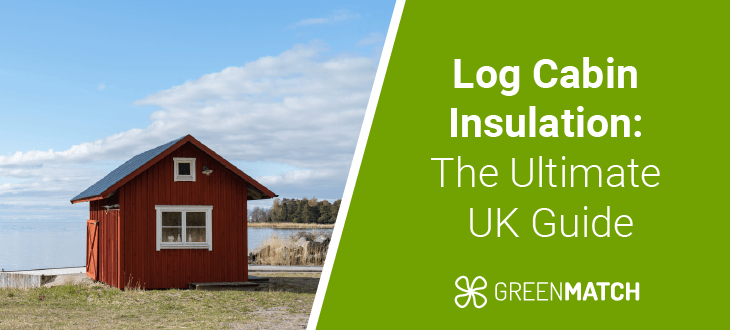
- Unlike traditional log cabins, insulated ones have additional insulation measures to create a thermal envelope, thus regulating temperature and moisture levels better.
- Log cabins that lack fundamental floor and wall insulation can quickly become a financial losing game with heating and moisture control, racking up hefty energy bills and mould growth early on.
- An insulated log cabin boasts wonderful sustainability and carbon reduction advantages, helping you pursue a healthier lifestyle while also benefitting the planet and saving drastically on heating costs.
Log cabins, whether in your garden or as a countryside getaway, are a charming and rustic lifestyle addition that allows us to embed in the nature around us and relax. Its quaint style brings a rural touch to any household.
There are thousands of cosy log cabins dotted across the UK, but how many of them have proper insulation measures in place? Unlike older times, we no longer have to rely on thick logs for cabin heating but can apply additional measures to achieve a long-lasting thermal solution for decades ahead.
This ultimate guide by GreenMatch UK will walk you through the essentials of a log cabin with insulation, how much it could cost, benefits and much more.
Ready to insulate your cabin? Let GreenMatch UK be your one-stop solution for all your needs. Through our network of pre-vetted professionals, we can send you up to 3 free home-tailored quotes free of charges and obligations. Simply fill out our 30-second online form and let the bargains come to you!
- Describe your needs
- Get free quotes
- Choose the best offer
It only takes 30 seconds



What areas of the log cabin can be insulated?
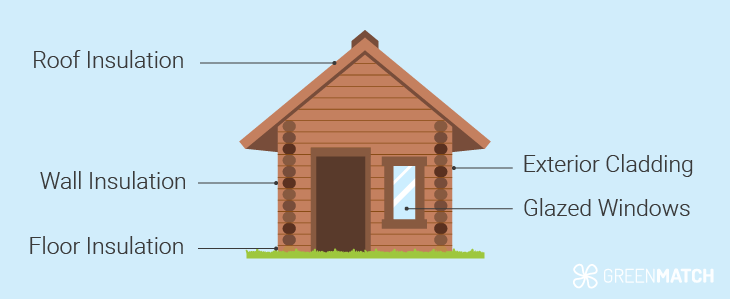
Log cabins are quite often a simple build, meaning they can make do with simple insulation measures. The most fundamental insulation measures that any log cabin will need are its floors, walls, and roof rafters, just like any property.
Additional measures such as window glazing, draught proofing, and cladding help to further secure the insulation material, improve heat retention, and boost the durability of your log cabin for an all-around finish.
Log cabin floor insulation
Due to their smaller size, log cabins lose a drastic amount of heat through their floors. Whether you have a newly built log cabin or an old one, adequate floor insulation will knock off an impressive 20% of your annual heating bills.
How do you insulate a log cabin floor?
The first step in insulating your log cabin floor is determining the type of floor you have. Log cabins will generally have standard tongue and groove wooden boards nailed to floor joists or bearers with a small air gap to prevent moisture from seeping into the floorboards. Some log cabins might even have concrete floors.
Luckily, insulating your log cabin floor is a relatively simple and cost-effective process. It’s even possible to carry out DIY. To insulate log cabin floors that have tongue and groove boards, you can follow these handy steps:
- Remove the cabin floorboards to reveal the small air gap underneath.
- Secure a series of screws halfway in to act as batons to balance your insulation boards. That way, they are not in direct contact with the floor and are at risk of moisture ingress.
- Once the screws are secured, cut to size and fit insulation material such as foil-backed insulation boards or rigid PIR in between the floor joists. Make sure the insulation fits snugly in the joist gaps to avoid any cold spots.
- Once in place, you can use foil tape to seal off any gaps manually and to hold the insulation material in place.
- Finally, add your floorboards back in place and secure them.
As for log cabins with concrete floors, the process is a bit simpler. You can add a vapour barrier to the floor, followed by rigid insulation boards and floorboards on top.
By following these simple steps, you can drastically improve the heat retention of your log cabin for a fraction of the cost it would take to insulate a home.
What is the best insulation for cabin floors?
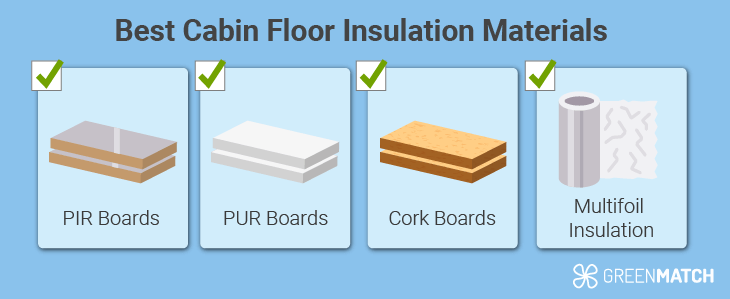
The best insulation material for cabin floors will depend on your floor type, budget range and other personal preferences. Either way, there is a range of popular materials that are suitable for log cabin floor insulation:
- PIR boards: Made from polyisocyanurate, a more effective insulator than PUR, this polymer-based material is renowned for its high thermal efficiency and durability. Costing around £5 – £15 per m2, PIR is also flame and smoke-proof, making it a safer option.
- PUR boards: Made from rigid polyurethane, this polymer insulation material is highly durable and thermally effective. Costing around £5 – £15 per m2, it’s a popular choice for many homes in the UK.
- Cork boards: Unlike PIR and PUR boards, cork is an all-natural and fully sustainable insulation material with an impressive r-value and durability. While it may cost a higher £17 - £22 per m2, it does not harm the planet and is entirely recyclable.
- Multifoil insulation: The most budget-friendly of the lot, multifoil insulation is a nice base layer for log cabin insulation, especially if you do not intend to live in it. It costs a remarkable £3 - £4 per m2 but is balanced with much weaker insulation capabilities.
Additional measures such as adding carpets can help further improve thermal insulation, whilst also providing some degree of soundproofing as well.
Log cabin roof insulation
Alongside the floors and walls, uninsulated roofs are responsible for a significant chunk of heat loss both in homes and log cabins. As a base rule, roofs must be insulated if you intend to create a thermally efficient and comfortable environment to live in.
Most log cabin roofs will have your standard pointy roof, with roof rafters that can be seen from within the cabin. These roof rafters can be fitted with insulation material and secured in place for an effective finish. Here’s what the process generally looks like:
- Make sure your log cabin roof rafters are clean, clear of debris and damage-free. Address any cold spots, gaps and openings by sealing them with spray foam, purpose tape or other alternatives.
- Install a vapour barrier to make sure there is a reduced risk of moisture ingress. To make it easier, you can also secure the vapour barrier directly onto the upper side of your insulation material if you opt for rigid boards.
- Cut to size and secure the rigid insulation boards in between the roof rafters. Make sure that they fit snugly to avoid any cold spots.
- Once the roof is fully fitted with insulation, tape up all the joints, seams and gaps to ensure the roof is fully sealed.
- Finally, secure the roof boarding on top for a seamless aesthetic finish, and to keep your roof insulation safe and secure.
While it is highly uncommon, some cabins may have flat roofs. Such cabins can be insulated in a similar way as explained above, or by adding external insulation to the roof and covering it with a vapour barrier and shingle.
The best roof insulation for log cabin roofs is rigid insulation board types such as PIR, PUR, cork boards, or the much less efficient but affordable multifoil insulation. This is because rigid insulation boards are much more durable, giving your log cabin enhanced security.
Log cabin wall insulation
Log cabin wall insulation is a measure that cannot be missed. Alongside drastically reducing heat loss, it’ll help create a temperature-regulated and comfortable indoor environment in your log cabin year-round.
Most log cabins will have walls composed of interlocking logs, fitted together with manual grooves to create a seamless finish with no visible gaps. The tighter the fit, and the thicker the logs, the more thermally efficient the log cabin is going to be.
As such, the most efficient insulation for log cabins is to build it correctly from the beginning. We recommend the use of thicker logs of 44mm or more to enhance thermal efficiency.
However, existing log cabins may not be temperature efficient, needing additional insulation measures. While there are many approaches to this, we recommend the following:
- Firstly make sure your log cabin walls are in good condition. Seal any gaps and openings with spray foam, silicone or other similar solutions for an air-tight finish.
- Apply a breathable membrane to your cabin wall panels from the inside. This can be found in most hardware and DIY shops and it helps to reduce condensation buildup.
- Then, secure rigid insulation boards on top of the breathable membrane, and secure plywood on top for a seamless finish.
Most log cabin walls derive their insulation capacity from their original build, but existing cabins can have their thermal efficiency boosted by following these simple steps. Costs of insulation for walls can vary depending on your wall type, chosen material and installation complexity.
In addition, insulation for doors and double glazing on windows can help further elevate your walls' thermal efficiency, making sure to account for any openings and drafts.
How much does it cost to insulate a log cabin?
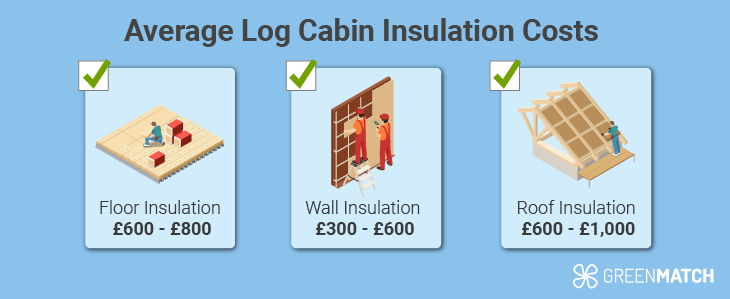
Providing an accurate cost to insulate a log cabin is difficult as many factors come into play. Your insulation prices will hinge on matters such as your cabin size, condition, existing insulation measures, chosen materials, and even location.
On average, floor, wall and loft insulation for a log cabin can cost around £1,500 - £2,400. Here is an average cost expectation breakdown for various insulation measures that can be carried out on an existing log cabin:
| Type of insulation | Average cost range |
|---|---|
| Floor insulation | £600 - £800 |
| Wall insulation | £300 - £600 |
| Roof insulation | £600 - £1,000 |
Some log cabin manufacturers also provide a log cabin insulation kit or package as part of the deal, which may be worth considering if you have yet to purchase or build your log cabin.
What are the benefits of log cabin insulation?
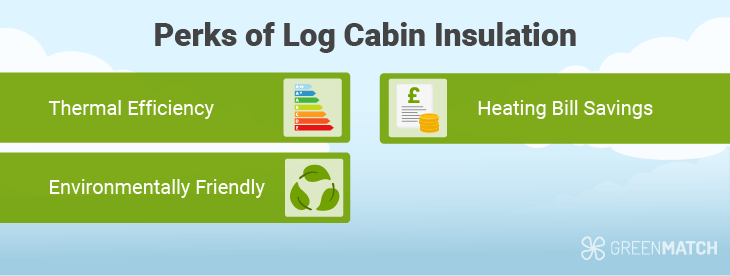
Properly insulating your log cabin will bring you plenty of benefits at a fraction of the cost it would take to insulate a full home. Here are some of the key perks you can expect to enjoy with a fully insulated log cabin:
Thermal efficiency
The most beneficial upgrade will be a log cabin that can retain heat when it’s cold out, and retain coolness when it's warm out. A temperature and moisture-regulated log cabin will provide you with year-round indoor comfort and peace of mind.
Heating bill savings
Thermal efficiency does not come without massive energy bill savings. Most hefty bills are racked up by heating systems that work overtime to compensate for lost heat. With proper insulation in place, you rely less on your heating system, leading to significant reductions in your energy bills.
Log cabin floor insulation alone has the potential to reduce your heating costs by up to 20%, so just imagine what a combination of wall and roof insulation will bring!
Environmentally friendly
Less use of a heating system will mean less carbon emissions. In turn, you can drastically reduce your domestic carbon footprint, benefitting the environment at large as well as your health.
Can you insulate a log cabin yourself?
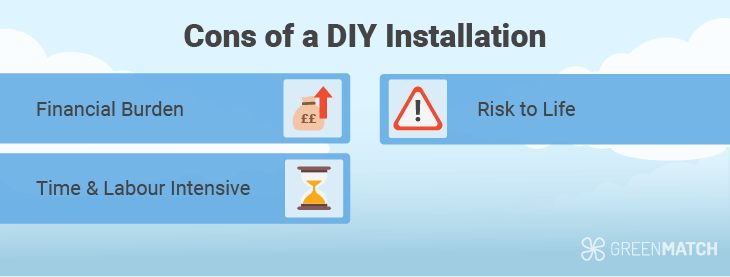
Due to the simpler nature of log cabin insulation, it’s possible to carry out the job DIY if you are an experienced handyman. This is especially true if your log cabin already has floor, roof and wall insulation, and all you need to do is draught-proof your cabin.
In any case, taking up a DIY job comes with its risks that are worth considering:
- Financial burden: A faulty installation can quickly rack up to become a financial disaster through structural damage and repair costs. A professional installation can guarantee that you avoid these problems.
- Risk to life: Poor craftsmanship can result in dangerous situations, such as flammability risks, poor electrical wiring, and structural instability, all of which can even pose a risk to life. A professional installer can account for a wide range of possibilities, making it worth the investment.
- Time and labour intensive: A DIY job will take far longer than a professional installation, as you will be required to research the steps, obtain all the necessary tools and materials, and carry out the job all by yourself. A professional can handle an entire insulation all in a day job.
Taking this into account, it’s highly recommended to work with a professional installer to ensure a secure job and peace of mind for your household.
Find local log cabin insulation installers
Deciding to insulate your log cabin is only the beginning of the journey. The next step is to land a professional installer who can do the job correctly for you. Check for multiple quotes from various installers to land the best bargain.
A professional installer can be the fine line between a well-insulated log cabin, and a financial disaster that keeps on racking up repair bills. Professionals are also able to work for a fraction of the time it would take for a DIY installation.
However, researching and vetting an endless list of installers can cost you hours upon hours. Luckily, that’s where GreenMatch UK comes in.
Through our nationwide network of pre-vetted professional installers, we can send you up to 3 free home-tailored quotes, completely free of charge and obligations. Simply fill out our 30-second form and let the bargains come to you. Click the button below to begin!
- Describe your needs
- Get free quotes
- Choose the best offer
It only takes 30 seconds



FAQ
Most log cabin floors have tongue and groove wooden boards nailed to floor joists with a small air gap to prevent moisture from seeping into the floorboards. These floorboards can be lifted, insulation boards can be added in between the joists, and then covered back up with floorboards for a seamless finish.
The best type of insulation for cabin floors is rigid insulation boards due to their durability, adding enhanced security to your log cabin. There are several options on the market, such as synthetic boards like PIR and PUR, but also environmentally friendly options like cork board.
For standard cabins with timber floors, rigid insulation boards are the most suited due to their added durability. Consider more environmentally friendly options such as cork boards over synthetic polymers like PIR or PUR.
Insulating a log cabin is worth the investment in all aspects, leading to significant heating bill savings, a comfortable and temperature-regulated indoors, and a reduced carbon footprint that benefits the planet at large.
The thickness of insulation used in a log cabin can differ depending on a few factors such as what you are insulating, the material you are using, and even the climate of your location. As a rule of thumb, more efficient materials can still insulate at less thicknesses, so when using rigid boards such as PIR or PUR, 25mm would be more than sufficient.

Akif is a copywriter at GreenMatch since 2023. With a keen interest in community sustainability, green solutions and the role of digital media in identifying climate trends, he aims to hone in on his background in International Studies and Digital Media to provide a multidisciplinary approach to written content rooted in credible research and accuracy.
We strive to connect our customers with the right product and supplier. Would you like to be part of GreenMatch?

- Log Cabin Insulation: What Are Your Options?
- What areas of the log cabin can be insulated?
- Log cabin floor insulation
- Log cabin roof insulation
- Log cabin wall insulation
- How much does it cost to insulate a log cabin?
- What are the benefits of log cabin insulation?
- Can you insulate a log cabin yourself?
- Find local log cabin insulation installers
- FAQ
